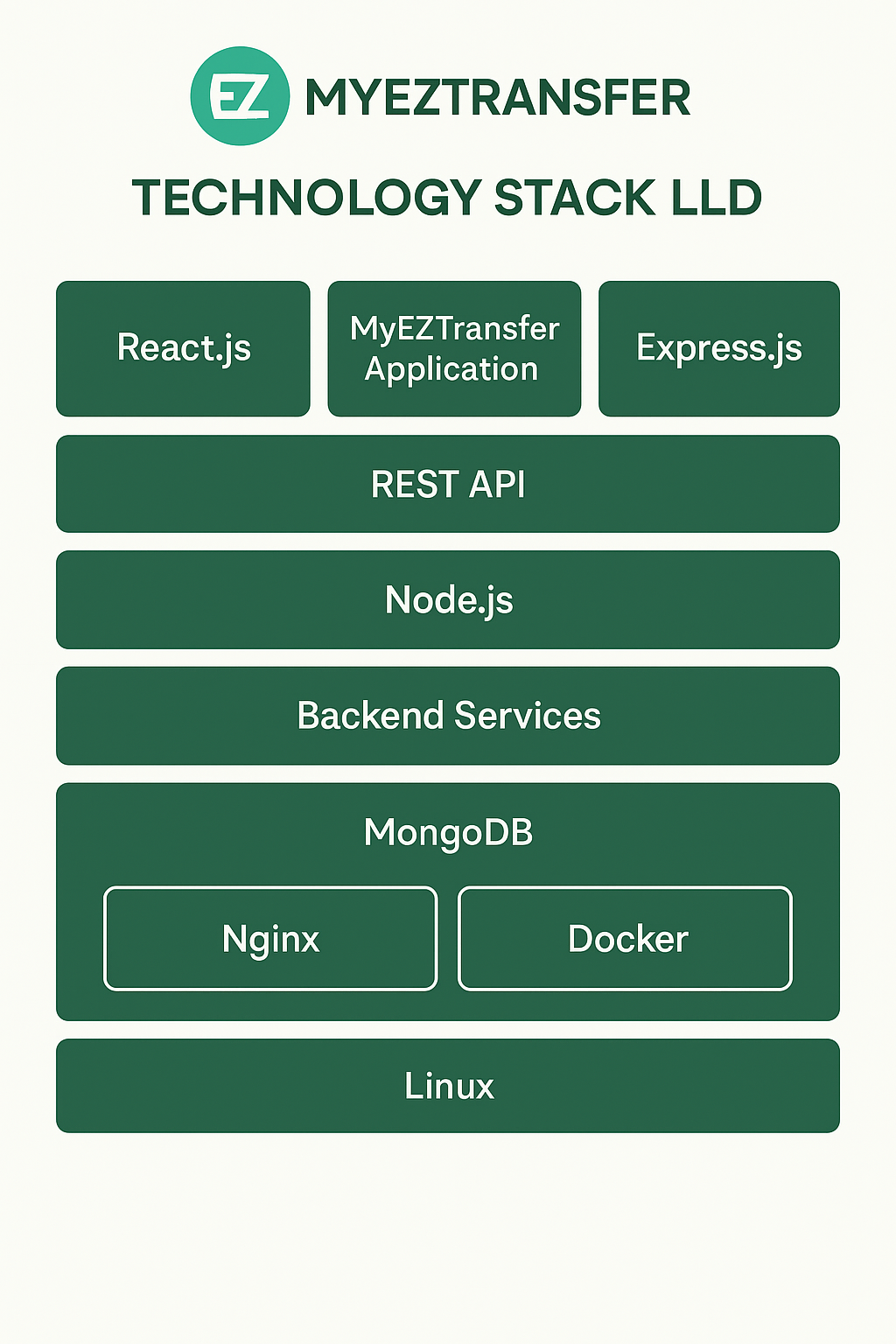The MyEZTransfer platform is hosted entirely on **Amazon Web Services (AWS)**, leveraging a robust and scalable cloud infrastructure designed to meet the high demands and stringent security requirements of a financial application. This document outlines the key AWS services utilized across compute, networking, storage, and operational domains.
Overall MyEZTransfer Technology Stack Diagram
This diagram provides a high-level overview of the core technology components that constitute the MyEZTransfer platform, including frontend, backend, and foundational infrastructure elements.
 Diagram: Core Technology Stack Components
Diagram: Core Technology Stack Components
Compute & Serverless
- Amazon EC2 (Elastic Compute Cloud): Provides scalable virtual servers for hosting core backend services (e.g., Django/Gunicorn, Node.js/Express.js).
- AWS Lambda: Used for event-driven, serverless functions, potentially for microservices, background processing, or specific API endpoints (e.g., QR code generation, notifications).
- Amazon ECS/EKS (Elastic Container Service/for Kubernetes): For container orchestration, managing Docker containers at scale, ensuring high availability and efficient resource utilization.
- AWS Fargate: Serverless compute engine for containers, abstracting away server management.
Networking & Content Delivery
- Amazon VPC (Virtual Private Cloud): Provides an isolated virtual network for all AWS resources, enabling fine-grained control over network configuration.
- AWS Security Groups & Network ACLs (NACLs): Act as virtual firewalls to control traffic at the instance and subnet levels, respectively.
- Elastic Load Balancing (ELB): Distributes incoming application traffic across multiple targets (e.g., EC2 instances, containers, Lambda functions) for high availability and fault tolerance. Includes Application Load Balancers (ALB) and Network Load Balancers (NLB).
- Amazon Route 53: Scalable cloud Domain Name System (DNS) web service, used for domain registration, DNS routing, and health checks.
- Amazon CloudFront: Content Delivery Network (CDN) service for securely delivering data, videos, applications, and APIs with low latency and high transfer speeds.
Databases & Storage
- Amazon RDS (Relational Database Service): Managed relational database service, likely hosting PostgreSQL for the Django backend.
- Amazon DynamoDB: Fast and flexible NoSQL database service, potentially used for high-performance, low-latency data access (e.g., session stores, real-time transaction logs).
- Amazon S3 (Simple Storage Service): Object storage service for static assets (frontend files, images), backups, and potentially generated documents (e.g., AML PDFs).
- Amazon ElastiCache (Redis): In-memory data store, used for caching and as a message broker for Celery background jobs.
Security, Monitoring & Management
- AWS IAM (Identity and Access Management): Manages user access to AWS services and resources, enforcing least privilege.
- AWS KMS (Key Management Service): Creates and manages cryptographic keys for data encryption.
- AWS WAF (Web Application Firewall): Protects web applications from common web exploits that could affect application availability, compromise security, or consume excessive resources.
- Amazon CloudWatch: Monitors AWS resources and applications, collecting and tracking metrics, collecting and monitoring log files, and setting alarms.
- AWS CloudTrail: Records API calls and related events made in your AWS account, providing a history of activity for auditing and compliance.
- Amazon GuardDuty: Intelligent threat detection service that continuously monitors for malicious activity and unauthorized behavior.
- AWS Config: Assesses, audits, and evaluates the configurations of your AWS resources, helping ensure compliance.
- VPC Flow Logs: Captures information about the IP traffic going to and from network interfaces in your VPC, useful for network forensics.
CI/CD & Developer Tools
- AWS CodeCommit: Securely hosts Git repositories.
- AWS CodeBuild: Compiles source code, runs tests, and produces deployable software packages.
- AWS CodeDeploy: Automates application deployments to various compute services like EC2, ECS, and Lambda.
- AWS CodePipeline: Automates the release pipelines for fast and reliable application and infrastructure updates.
- **AWS Systems Manager:** Provides visibility and control over your AWS infrastructure, simplifying operational tasks.
